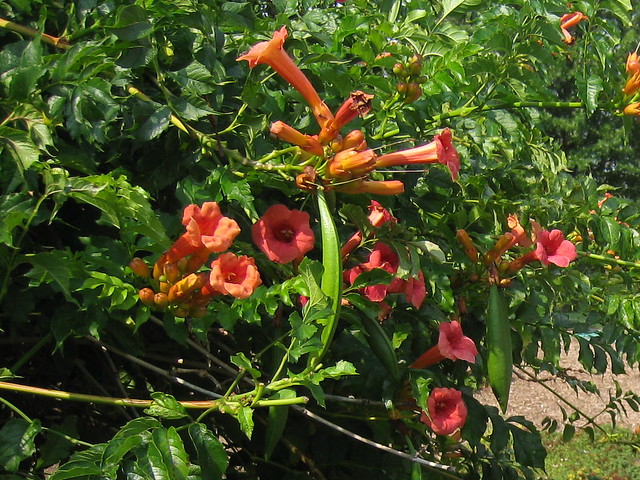 |
| Hummingbird throwdown! Photo by Amyn Kassam |
Here’s what we love about hummingbirds: They have that vertical posture, they make eye contact, they love sweets, and of course, they fight. They’re so human!
Watching hummingbirds is not like watching other wildlife. Hummers get up close and personal. Laura Erickson, in her 2006 book, 101 Ways to Help Birds, tells us about hummers that tap on her window when they want her attention. I watched a hummingbird pirouette around a friend wearing a coral-colored shirt, even though he was surrounded by a crowd partying on a small deck. Hummers have come within inches of my face to catch the spray as I water my plants.
My neighbor recently told me about two hummers that clashed and then crashed, knocking each other to the ground right in front of his basset hound. Both recovered and flew off before the dog could get over her surprise and devour them. Last summer, a skirmishing hummer clobbered my brother-in-law in the head!
The level of aggression in hummingbirds is a mystery to me. Isn’t fighting over resources a waste of valuable foraging and feeding time? In her 2000 book, Attracting and Feeding Hummingbirds, Sheri Williamson points out that plants must be frugal with the nectar they produce. Nectar is of no use to the plant directly. It’s sole purpose is to pull in pollinators, so once a blossom has been pollinated, it ceases to produce nectar. Since plants are so stingy, hummers adopt a strategy of claiming a territory and protecting their resource ferociously. According to Williamson, “Territories are smaller where flowers are abundant, larger where they are scarce (14).” I can see the evolutionary advantage of resource guarding, but I’m not sure why it seems so much stronger in hummers than—say—woodpeckers.
Like grizzly bears and bull elephants, hummingbirds use “mock charges” to panic their rival into flight, while minimizing the risk of injury to themselves. Adult males can flash their color throat feathers (the gorget) to intimidate from a distance. Females and juvenile bird display the white tips of the outer tail feathers for the same purpose, as you see in the photo above by my Flickr friend, Amyn Kassam. Hummingbirds can scold predators and interlopers with chirping sounds, and some can startle with buzzing sounds produced by tail or wing feathers. There are times however when, like Taryton smokers, hummingbirds would rather fight than switch.
Some of my readers know that I worked at a youth camp in the Ozarks for many summers. Trumpet creepers (Campsis radicans) brought in birds by the dozen. Like Snoopy and the Red Baron, hummers battled around the camp office from sun up till sundown. Once, a staff member was actually injured in a hummingbird fight. As she crossed the parking lot, two hummers collided in front of her and a dislodged feather hit her in the eye!
 |
| Trumpet Creeper is a hummingbird magnet! Photo by AMcCormack |
Trumpet creeper is a hummingbird magnet for a reason. In a 2003 article in LOS News, the newsletter of the Louisiana Ornithological Society, Dennis Demcheck wrote about the “Sugar Content of Hummingbird Plants in Louisiana Gardens.” Demcheck used a refractometer to measure the concentration of sugar in the nectar of blossoms in his garden—the same equipment used by wine makers. He found that, among wild/native plants, the trumpet creeper had the highest concentration of sugar at 34.3%, with each bloom producing a large volume of nectar. To reach that nectar, the bird must actually climb inside the 3-inch long bloom. It’s quite a risk for a bird to limit its vision like that, but obviously worth it.
If you’re thinking about adding trumpet creeper to your home garden, linger on this blog a little longer. Trumpet creeper is a big plant; every bit as aggressive as the hummers that love it. The main stem can be wider than your hand and all those branches in summer are heavy as they lie on the roof of your garage or branches of your prized specimen tree. Maybe you can persuade your neighbor to grow it.
They are fascinating! And because they're so little, that aggression is pretty entertaining. Thanks for the comment!
ReplyDelete